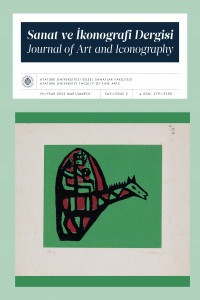Abstract
İlk çağlardan beri önemli bir yerleşim yeri olan Aydın ve çevresi, birçok medeniyete ev sahipliği yapmış, bu medeniyetlerden kalan eserlerle zengin bir arkeoloji ve sanat tarihi potansiyeline kavuşmuştur. Osmanlı İmparatorluğu’nun 18. Yüzyılın başlarındanitibaren güç kaybetmesiyle beraber yerel yönetimler sahneye çıkmış, Anadolu’nun birçok yerinde otonom sistemi dâhilindehareket ederek bulundukları toprakları yönetmişlerdir. Bu yerel yönetimlerden birisi olan Posacızade Ailesi: Aydın ve çevresinde hâkim durumda olan Cihanoğlu Beyliği’nin zayıflaması ile nüfuz kazanmış, Aydın şehir merkezinin güneyinde, yirmi bir kilometre uzaklıkta yer alan Karahayıt Köyü ve çevresine yerleşmiştir. Posacızade Ailesi; eğitim, sosyal ve kültürel alanda aktif rol oynamışlar,vakıflar kurarak Karahayıt ve çevresi ile Aydın Güzelhisar’ında cami, medrese, mektep, çeşme ve sebil gibi eserler yaptırmışlardır. Posacızade Ailesi’nin yaptırdığı bu eserlerde Osmanlı Devleti’nin son döneminde etkili olan batılılaşma özelliklerini izlemek mümkündür. Son dönem batılılaşma ile gelen ve Ege Bölgesi’nin plan, mimari ve dekorasyon özellikleri ile birlikte harmanlanan buu eserlerin birçoğu günümüze kadar gelmese de Karahayıt Köyü’nde yaptırdıkları cami, mescit, sebil ve çeşme değişikliklere uğramasına rağmen hala ayaktadırlar.
Keywords
References
- Akcan, E. (2014). Aydın VilayetiMudafaa-iMilliye cemiyeti bazı faaliyetleri.Ankara Üniversitesi İnkılap Tarihi Enstitüsü Atatürk Yolu Dergisi, (54) 16-17.
- Aslanapa, O. (2004). Osmanlı devri mimarisi. İstanbul.
- Cavid, İ. (2010). Aydın vilayet salnamesi R.1307/H.1308. Türk Tarih Kurumu.
- Çelik, B., Demir, T. Osmanlı döneminde Aydın Güzelhisarı.Aydın İl Tarihi, Ankara.
- Demir, T., Ülkü, O., Çelik, B. (2021).Aydın’da vakıflar ve vakıf eserleri (XIV-XX. Yüzyıllar).Sosyal Kalkınma ve Vakıf, 251-283.
- Güneş, G., Başaran, M. (2012).Milli Mücadele dönemindeAydın.Aydın İlTarihi, Ankara 123-125.
- Sarıbey, A. (2006).XIX. yüzyılın ilk yarısında Aydında yönetim, [Yayımlanmamış yüksek lisans tezi]Adnan Menderes Üniversitesi.
- Sarıbey, A., Can Tunalı, A. (2012).XIX. yüzyılda Aydın.Aydın İl Tarihi, Ankara.
- Ülkü,O. (2016).Osmanlı Mimarisinde Manzara Resimleri Süslemeciliği Bağlamında Koçarlı-Cincin Köyü Cihanoğlu Hacı Abdülaziz Efendi Camii Duvar Süslemelerinin Değerlendirilmesi. Sanat Tarihi Dergisi. XXV(2) 275-290.
Abstract
Aydın and its surroundings, which have been an important settlement since the early ages, have hosted many civilizations and have gaineda rich archeology and art history potential with the works left behind by these civilizations. Local governments emerged on the scene with the loss of power of Ottoman Empire from the beginning of the 18th century and ruled the lands where they were in byacting within the autonomous system in many parts of Anatolia. Posacızade Family, one of these local governments, gained influence with the weakening of Cihanoğlu Family, which was dominant in Aydın and its surroundings, and settled in the Karahayıt Village and its surroundings, located twenty one kilometers south of Aydın city center. Posacızade Family played an active role in education, social and cultural fields, and they established foundations and built works such as mosques, madrasahs, schools, fountains and public fountains in Karahayıt and its surroundings and Aydın Güzelhisar. It is possible to follow the westernization features that were effective in the last period of the Ottoman Empire in these works built by the Posacızade Family. Although manyof these works, which came with the recent westernization and blended with the plan, architecture and decoration features of the Aegean Region, have not survived to the present day, the mosque, small mosque, public fountain and fountain they had built in Karahayıt Village are still standing, although they have undergone changes.
References
- Akcan, E. (2014). Aydın VilayetiMudafaa-iMilliye cemiyeti bazı faaliyetleri.Ankara Üniversitesi İnkılap Tarihi Enstitüsü Atatürk Yolu Dergisi, (54) 16-17.
- Aslanapa, O. (2004). Osmanlı devri mimarisi. İstanbul.
- Cavid, İ. (2010). Aydın vilayet salnamesi R.1307/H.1308. Türk Tarih Kurumu.
- Çelik, B., Demir, T. Osmanlı döneminde Aydın Güzelhisarı.Aydın İl Tarihi, Ankara.
- Demir, T., Ülkü, O., Çelik, B. (2021).Aydın’da vakıflar ve vakıf eserleri (XIV-XX. Yüzyıllar).Sosyal Kalkınma ve Vakıf, 251-283.
- Güneş, G., Başaran, M. (2012).Milli Mücadele dönemindeAydın.Aydın İlTarihi, Ankara 123-125.
- Sarıbey, A. (2006).XIX. yüzyılın ilk yarısında Aydında yönetim, [Yayımlanmamış yüksek lisans tezi]Adnan Menderes Üniversitesi.
- Sarıbey, A., Can Tunalı, A. (2012).XIX. yüzyılda Aydın.Aydın İl Tarihi, Ankara.
- Ülkü,O. (2016).Osmanlı Mimarisinde Manzara Resimleri Süslemeciliği Bağlamında Koçarlı-Cincin Köyü Cihanoğlu Hacı Abdülaziz Efendi Camii Duvar Süslemelerinin Değerlendirilmesi. Sanat Tarihi Dergisi. XXV(2) 275-290.
Details
| Primary Language | Turkish |
|---|---|
| Journal Section | Research Articles |
| Authors | |
| Publication Date | March 30, 2022 |
| Published in Issue | Year 2022 Issue: 2 |
Journal of Art and Iconography is licensed under a Creative Commons Attribution NonCommercial 4.0 International License.


